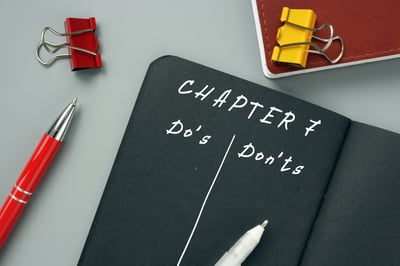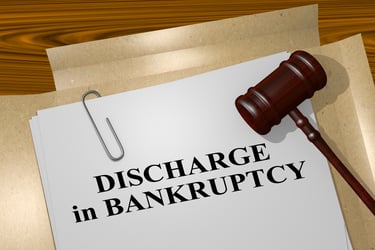 A lot of Americans want to know, how does a Chapter 7 Bankruptcy really work? This article dissects a Chapter 7 Bankruptcy from the moment it becomes a thought in your head to when you actually get your life back after bankruptcy.
A lot of Americans want to know, how does a Chapter 7 Bankruptcy really work? This article dissects a Chapter 7 Bankruptcy from the moment it becomes a thought in your head to when you actually get your life back after bankruptcy.
Banish the Anxiety of Filing Chapter 7 Bankruptcy in Minnesota
The first step is always the biggest as they say. The first step to Chapter 7 Bankruptcy is to think about Chapter 7 Bankruptcy without vomiting. I am serious.
For a lot of people the very thought of a Chapter 7 Bankruptcy is so scary, a person is inclined to flip that switch off in your brain and the Chapter 7 thought escapes your mind as soon as it came into your mind. But, stay with me for a second. Allow yourself to think about Chapter 7 Bankruptcy and feel the fear and push through it. Like so many other anxiety producing things, if you allow yourself to feel the fear and push your way through it, you will be so thankful you did.
Schedule a Chat With a MN Chapter 7 Bankruptcy Lawyer
 Once you have thought about Chapter 7 Bankruptcy, and felt the fear and realized the thought did not kill you, move on to the next step. Schedule a chat with a bankruptcy lawyer. Now, I will tell you, that this is where many people go wrong.
Once you have thought about Chapter 7 Bankruptcy, and felt the fear and realized the thought did not kill you, move on to the next step. Schedule a chat with a bankruptcy lawyer. Now, I will tell you, that this is where many people go wrong.
Often people choose a bankruptcy lawyer in Minnesota far too fast and then sometimes regret not taking longer to choose the right bankruptcy lawyer. I have heard that a lot. I think if you take 15-20 minutes of your time, you will find an awesome bankruptcy lawyer.
Here are simple steps you can take when choosing a Chapter 7 Bankruptcy lawyer:
- Create a list of 3-4 bankruptcy firms in your area that do nothing but Chapter 7 and 13 work.
- Look at their Google reviews. Do other people who have used them like them? If they had negative reviews, what was the client complaint and how did the firm respond to the negative reviews? Try to choose the highest Google reviewed bankruptcy law firm.
- Look at their website closely. Is their website kind and helpful? Does their website give you a lot of meaningful information laid out in a helpful way? Or, is their website stingy on information and really more gimmicky? This should help you narrow down your choices.
- Finally, meet with the lawyer. View the meeting like an interview. Is this lawyer, and their staff, kind and helpful, or are they cold and antiseptic? Trust your gut. If your gut tells you this is not the one move on until your gut tells you, you have found the one.
The Bankruptcy Chapter 7 Sign Up Process in Minnesota
 When you're ready to start the Chapter 7 process in Minnesota, your lawyer will guide you through the various steps:
When you're ready to start the Chapter 7 process in Minnesota, your lawyer will guide you through the various steps:
- Bankruptcy Retainer Agreement
- Credit Counseling Course
- Review and Sign Appointment
- Bankruptcy Filing
- Section 341 Meeting
- Post Filing Debt Management Class
- Discharge
- Post-Discharge Issues.
1. The MN Chapter 7 Bankruptcy Retainer Agreement
When you reach the point of signing up with a bankruptcy law firm to help you file Chapter 7 Bankruptcy, they will have you review and sign a Chapter 7 Bankruptcy retainer agreement. Review the retainer agreement and make sure it is what you agreed to. Once retained, the bankruptcy law firm works for you. The bankruptcy law firm fields phone calls from your creditors and protects you from your creditors. At the same, time, the bankruptcy law firm prepares the necessary paperwork for your bankruptcy to be filed with the court.
Often, the bankruptcy team will pull public reports like credit reports to merge the creditor information from the public reports into your bankruptcy schedules. Also, public reports may get pulled like Lexis Nexis reports that pull public information on you concerning vehicle and real estate ownership. These items will be gone over with you when you meet to finalize your bankruptcy schedules.
2. A Mandatory Minnesota Credit Counseling Course
Congress has made it a requirement that each debtor filing bankruptcy must go through a credit counseling course provided by an approved credit counseling provider by the United States Trustee’s office prior to filing bankruptcy. Your attorney/team will give you access to a credit counseling course you can take on-line prior to your review and sign appointment.
Typically, this credit counseling course takes 1 hour or less. At the end of the course, you will receive a certificate of attendance. When you use a code provided by the attorney, the attorney’s office is also provided a copy of this certificate as well.
3. THE REVIEW AND SIGN APPOINTMENT
 Next, you meet with your bankruptcy attorney/staff/team to go over your bankruptcy schedules before filing he schedules with the bankruptcy court. When you sign the bankruptcy schedules you are signing them under penalty of perjury. That is why it is imperative the schedules be true, correct, and complete. This why you never file bankruptcy by yourself without an attorney. That is a major blunder we see and when we see it occur, it is often not pretty.
Next, you meet with your bankruptcy attorney/staff/team to go over your bankruptcy schedules before filing he schedules with the bankruptcy court. When you sign the bankruptcy schedules you are signing them under penalty of perjury. That is why it is imperative the schedules be true, correct, and complete. This why you never file bankruptcy by yourself without an attorney. That is a major blunder we see and when we see it occur, it is often not pretty.
At the review and sign appointment, you will go over each and every page of the bankruptcy schedules to make sure the information on it is true, correct, and complete. The attorney you hired will go through the public documents that were pulled in advance of the appointment with you to make sure all assets/transfers/creditors are accounted for in the schedules prior to filing.
I cannot stress the importance of this appointment enough. Following this appointment, your attorney will send you a copy of the revised bankruptcy schedules (revised after the information and answers you provided at the review and sign appointment are synthesized into the bankruptcy schedules). From there, you will review the paperwork one final time.
Upon final review, make sure that all your assets are listed, all your creditors are listed, and that the information in the schedules is true, complete, and correct. By the way, if your lawyer is skipping any of these steps, get your money back and go to a different firm.
4. Filing the Bankruptcy in Minnesota
In the olden days, bankruptcies were filed with the court by mailing 3 copies of the petition and schedules along with a check for the file fee to the bankruptcy court. You never really knew your actual date of filing until the court told you this is the day we received it in the mail, and therefore, this is your date of filing. Today, everything is electronic. Once the schedules are final, the bankruptcy lawyer’s staff file the schedules with the bankruptcy court electronically.
Once filed, you have officially filed bankruptcy and you not only know the date you filed the bankruptcy but the time as well. The file fee is collected by tying a law firm credit card to the bankruptcy court who collects the fee from the law firm each time a case is filed.
5. The Automatic Stay in Minnesota
Immediately upon filing, Section 362 of the Bankruptcy Code imposes a court ordered and sanctioned ban against most, but not all, collection activity against debtor. This is called the Automatic Stay. There are exclusions to this general ban on collection activity. For example, child support and alimony can still be deducted from your income and paid over to the recipient.
Most collection activity must cease upon filing. This includes, but is not limited to, garnishments and bank account levies for collection on general unsecured debt like credit cards or medical bills, foreclosure sales, and repossessions. The power that debtors have to stop collection activity is enormous. If Section 362 of the Bankruptcy Code is violated by creditors, debtors can and do bring actions against creditors for violating the automatic stay. Recently, I seen one of these egregious violations of the stay result in a $95,000.00 settlement in favor of debtor.
What is the general purpose of Section 362 of the Bankruptcy Code or the automatic stay? To call a time out on the debtor’s financial situation and allow debtor/trustee a chance to orderly administer debtor’s affairs.
6. The Minnesota Section 341 Meeting Defined
 After filing for Chapter 7 Bankruptcy, the bankruptcy court sends notice to you and your creditors of an upcoming Section 341 bankruptcy hearing. It is called a first meeting of creditors or a Section 341 meeting because it refers to Section 341 of the Bankruptcy Code which requires a hearing to take place.
After filing for Chapter 7 Bankruptcy, the bankruptcy court sends notice to you and your creditors of an upcoming Section 341 bankruptcy hearing. It is called a first meeting of creditors or a Section 341 meeting because it refers to Section 341 of the Bankruptcy Code which requires a hearing to take place.
The notice sent by the court notifies debtor and debtor’s creditors who has been assigned by the US Trustee’s office to administer the bankruptcy estate. This person is called a trustee and is typically a person who is a lawyer who has met the requirements to be impaneled as a Chapter 7 trustee. Typically, when Chapter 7 cases are filed with the court, the court assigns a trustee to the case until her calendar is full for a particular hearing date and then another trustee is assigned to fill a hearing date and so forth.
The notice sent by the court also designates a date and time for the Section 341 hearing. Typically, these hearings take place in-person (unless there is a pandemic where hearings may be conducted by telephone or Zoom).
The Minnesota Section 341 Meeting in Action
Who is present at these hearings? While creditors have the right to appear, they seldom do. The vast majority of the hearings take place without any creditors present. Typically, those present include, yourself, your lawyer, and the Chapter 7 trustee. That is it.
The purpose of this hearing is to question the debtor as to whether the information on the schedules is true, correct, and complete. If you and your lawyer have thoughtfully prepared these schedules, this hearing is smooth. If the schedules are a mess and omit assets and other pertinent information that should have been disclosed, this hearing can be a little rough.
This is why I cannot emphasize enough hiring a lawyer who is from a law firm of many people who are a team that does nothing else except Chapter 7 and Chapter 13 Bankruptcy work. There is nothing worse than seeing a debtor struggle because debtor chose a cheap lawyer who places more emphasis on volume than quality and worse, a debtor who thought it was a good idea to file a bankruptcy themselves. Both are terrible ideas.
When Your MN 341 Meeting Is Continued to a Later Date
While there typically is only one meeting of creditors, Chapter 7 trustees can continue the hearing until a later date if there is more testimony that is needed. This is unusual but does occur. Just because the Section 341 hearing has been completed does not mean the trustee will not need other information from debtor to properly administer the case.
Trustee’s often ask for follow up documents and other information to administer the debtor’s case. Debtors have a duty to cooperate fully with the trustee or risk losing their bankruptcy discharge. Trustees should not have to repeatedly ask for information or babysit debtors and their lawyers to comply with reasonable trustee requests.
Too often we see volume firms who think quantity is better than quality think their job is done after the Section 341 hearing. When debtors start calling the court or other bankruptcy attorneys that is when you know you have hired the wrong bankruptcy law firm.
7. POST FILING DEBT MANAGEMENT CLASS in Mn
While a credit counseling certificate is the ticket into bankruptcy, the ticket out of bankruptcy is a post filing debt management class certificate. Failure to file a debt management certificate with the bankruptcy court will result in your bankruptcy case being closed without the benefit of a discharge. Should that occur it will be as if you never filed bankruptcy to begin with and your creditors are once again free to try and collect from you.
Most debtors I know do not find this funny. The course can typically be done on-line or by phone and takes about 2 hours to complete.
8. Chapter 7 Discharge in Minnesota
 About 60 days after your Section 341 hearing, you should receive a Chapter 7 bankruptcy discharge. What is a discharge and what does it mean? A Chapter 7 Bankruptcy discharge means your liability on all discharged debts has now been extinguished. Creditors can no longer try and collect any portion of the discharged debt in which your liability has been extinguished now or in perpetuity. Plus, your liability is discharged from the debt, tax free.
About 60 days after your Section 341 hearing, you should receive a Chapter 7 bankruptcy discharge. What is a discharge and what does it mean? A Chapter 7 Bankruptcy discharge means your liability on all discharged debts has now been extinguished. Creditors can no longer try and collect any portion of the discharged debt in which your liability has been extinguished now or in perpetuity. Plus, your liability is discharged from the debt, tax free.
This is where it can get a little confusing. Creditors will write off the discharged debt on their taxes as a loss. That will generate a 1099 from the creditor to you that the IRS and other taxing authorities may see. You should make sure and file IRS Form 982 with the IRS which lets the IRS know that you filed bankruptcy and the debt forgiven in the 1099 is not taxable to you. This becomes a special sort of heartache when you receive a 1099 after you have filed your taxes and you did not file IRS Form 982.
The discharge is the goal of every Chapter 7 Bankruptcy case. It is what we work towards from the inception of the bankruptcy filing. But just because debtor receives a discharge, does not mean that all bankruptcy issues are resolved.
9. Minnesota Post-Discharge Issues
When you are suffering from overwhelming debt, obtaining a discharge is wonderful and can propel you and your family forward. However, there are a few things we think you should be aware of as well:
- A bankruptcy discharge does not clear the public record. In other words, if you have judgments entered against you prior to filing bankruptcy, those judgment don’t magically disappear from the public record when you get a bankruptcy discharge. For example, in Minnesota, there is a statutory process for removing judgments from the public record following a bankruptcy discharge.
- Credit reports need to be pulled about 30 days after receiving a bankruptcy discharge to make sure the reports are accurate. Practice note: credit reports are impacted by many human beings who do make mistakes. These reports need to be checked and updated to make sure they are reflecting accurate information.
- Make sure you file IRS Form 982 with your tax return the year you file the bankruptcy case. This will notify the IRS that any debt forgiven as part of a Title 11 Bankruptcy, which includes Chapter 7 Bankruptcy, is not taxable income to you.
- It is always helpful to learn some nuggets to improve your credit profile and credit score post filing bankruptcy. Getting rid of unwanted debt is a huge step in that direction. However, there are other simple and easy ways to improve your credit score and profile you will want to check into.
- Some quality bankruptcy law firms maintain a list of helpful professionals who are knowledgeable about bankruptcy and obtaining credit to purchase homes and cars and other things. If you have access to a list like this, take advantage of it.
The Dangers of Filing Chapter 7 in MN Without a Lawyer
 Filing Chapter 7 Bankruptcy is an effective tool to eliminate unwanted debt. The above describes the process of filing and obtaining a Chapter 7 Bankruptcy discharge. If I had one word of caution for any prospective debtor it is this: Do not file Chapter 7 Bankruptcy yourself.
Filing Chapter 7 Bankruptcy is an effective tool to eliminate unwanted debt. The above describes the process of filing and obtaining a Chapter 7 Bankruptcy discharge. If I had one word of caution for any prospective debtor it is this: Do not file Chapter 7 Bankruptcy yourself.
This is far too complicated and important of an issue to do this yourself. I learned in law school that a client who represents themselves has a fool for a client. Even attorneys hire other attorneys when they need legal representation. A quality bankruptcy law firm does not cost you money, it saves you a ton of money. Spend at least 15 minutes looking for a quality bankruptcy law firm.
You will recognize a quality bankruptcy law firm by taking 15 minutes and looking at these criteria:
- Make sure the law firm does 100% Chapter 7 and 13 Bankruptcy work and nothing else.
- Make sure the bankruptcy law firm has a thoughtful and well laid out website that gives you the information the way you want it (either simple, medium, or in depth).
- Read A LOT of their reviews and watch out for warning signs like they will not call me back or terrible communication etc.
- Choose highly reviewed bankruptcy law firms as opposed to only a few reviews. My experience is it is very difficult to get a bankruptcy client (for obvious reasons) to leave a public Google review. When they do leave a positive public Google review about their bankruptcy experience with a particular law firm it says a lot.
- You first contact with the firm is antiseptic/rude/indifferent take that as a huge red flag and move on to a different law firm. I cannot tell you how many times I have had clients tell me they wished they would have spent a few more minutes researching bankruptcy lawyers before choosing one.
CALL NOW FOR A FREE STRATEGY SESSION FROM A MN BANKRUPTCY LAWYER AT KAIN & SCOTT
Good luck to you and your family. The courage it takes to reach out for help in solving a debt problem is huge. That courage should be honored by the firm you work with. For more information, see Wes Scott at www.kainscott.com.


